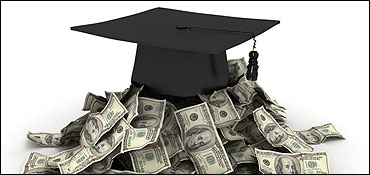Higher education may be a great investment, but it isn’t cheap! Student loan debt is has now reached more than $1 trillion, according to the  Consumer Financial Protection Bureau. In fact, the combined American debt for student loans is far greater than debt on credit cards or car loans.
Consumer Financial Protection Bureau. In fact, the combined American debt for student loans is far greater than debt on credit cards or car loans.
If you graduated college and were able to get a job in your field and bring home a paycheck that easily covered your student loan payments in addition to your monthly expenses, you were one of the lucky ones. For others, life didn’t go as planned. So what can you do if your student loans are spiraling out of control? Or if you are managing the payments, is there a better payment plan?
The first step is to determine what type of loan you have. Is it a federal loan or a private loan? This is important because your choices and protections are quite different for each loan type. You can usually recognize a private loan if you were required to have a credit check, if you had to have a co-signer, or if the interest rate is very high (over 7%). Federal loans, on the other hand, don’t usually need a co-signer or check credit (except for PLUS loans), and the interest rate for federal loans was capped at 6.8% in 2010. Not sure which type of loan you have? Try the Department of Education’s National Student Loan Data System (NSLDS): www.nslds.ed.gov or 800-4-FED-AID. It will tell you your loan balance and the type of loan.
Next, you need to discover your options. If you have a private loan, your choices are limited. You can look at your loan agreement papers to see if they spell out any relief options. Or you can contact your lender, explain your situation, and try to negotiate lower monthly payments or a reduction of your principle balance.
Do you have a federal loan? This is good news, because you have more options…
- Loan Cancellation or Discharge – you may qualify to have your loan cancelled or reduced under a few limited circumstances, like becoming permanently disabled, or if the school you attended went defunct. Members of the military, certain public professions (like teaching or nursing) may also qualify. Find more info here: www.studentloanborrowerassistance.org
- Deferment – You may be able to delay making payments for a year or longer, and your interest may be paid for you during this time. Deferment is available to people who return to school, are unemployed, have an economic hardship, or enter the military.
- Forbearance – Under forbearance, you are able to stop making payments for a period of time, but your interest continues to accumulate. Many situations that don’t qualify for deferment can request forbearance.
- Payment Plans – If you don’t qualify for one of the options above, you may be able to arrange a payment plan that will help your situation. The usual setup is to repay your loan over 10 years. However, this can be extended to 25 years for large loans (more than $30,000), or it can be arranged so the payment starts very small and increases every 2 years. This is called the Graduated Repayment Plan, and it is designed for people who expect their circumstances to improve. Other repayment plans are based on your income if you are not making much money. More information and a calculator can be found at: www.ibrinfo.org and www.finaid.org.
If you think you might qualify for one of these options, don’t wait! It usually takes nine months from the first missed payment before a federal student loan will go into default, but that is a situation better avoided. The sooner you get help, the better!
Want more information? Try this step-by-step guide from the Consumer Financial Protection Bureau: http://www.consumerfinance.gov/paying-for-college/repay-student-debt/#Question-1
Written by: Betsy DeMatteo, Family & Consumer Science Educator
Sources:
Consumer Financial Protection Bureau: http://www.consumerfinance.gov/paying-for-college/
Loonin, D. (2010). Guide to Surviving Debt. National Consumer Law Center, Inc., Boston.

